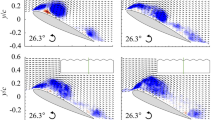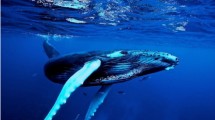Abstract
The hydrodynamic effects of leading-edge (LE) tubercles, inspired by the flipper of humpback whales, has become a subject of interest for the control of flow over lifting surfaces. The primary focus of these efforts has centered on static cases where the angle-of-attack (AoA) of the flow is held constant. However, given the dynamic nature of the use of these flippers by humpback whales, there may also be benefit in dynamic scenarios as well. The investigation of flow control of dynamically actuated airfoils with LE tubercles is much more limited compared with the static studies. The results to date show that these bio-inspired airfoils expand the operating envelope for dynamic stall by enhancing lift and delaying stall to higher angles. These results indicate that applications such as on helicopter rotors and wind turbines may be able to avoid the detrimental effects of dynamic stall leading to more efficient devices, or to even better utilize its effects.
Access this chapter
Tax calculation will be finalised at checkout
Purchases are for personal use only
Similar content being viewed by others
References
Anderson JM, Streitlien K, Barrett DS, Triantafyllou MS (1998) Oscillating foils of high propulsive efficiency. J Fluid Mech 360:41–72
Bai CJ, Lin YY, Lin SY, Wang WC (2005) Computational fluid dynamics analysis of the vertical axis wind turbine blade with tubercle leading edge. J Renew Sustain Ener 7(3):033124
Barwey D, Gaonkar GH (1994) Dynamic-stall and structural-modeling effects on helicopter blade stability with experimental correlation. AIAA J 32(4):811–819
Biava M, Khier W, Vigevano L (2012) CFD prediction of air flow past a full helicopter configuration. Aerosp Sci Technol 19:3–18
Bohl DG, Foss JF (1999) Near exit plane effects caused by primary-plus-secondary tabs. AIAA J 37(2):192–201
Bohl DG, Koochesfahani MM (2009) MTV measurements of the vortical field in the wake of an airfoil oscillating at high reduced frequency. J Fluid Mech 620:63–88
Borg J (2012) The effect of leading edge serrations on dynamic stall. PhD Thesis University of Southampton
Cai C, Zuo Z, Morimoto M, Maeda T, Kamada Y, Liu S (2018) Two-step stall characteristic of an airfoil with a single leading-edge protuberance. AIAA J 56(1):64–77
Carr LW, McAlister KW, McCroskey WJ (1977) Analysis of the development of dynamic stall based on oscillating airfoil experiments. NASA Technical Note D-8382
Conlisk AT (2001) Modern helicopter rotor aerodynamics. Prog Aero Sp Sci 37:419–476
Custodio D (2007) The effect of humpback whale-like leading edge protuberances on hydrofoil performance. Masters Thesis Worcester Polytechnic Institute
Dabiri JO (2005) On the estimation of swimming and flying forces from wake measurements. J Exp Biol 208(18):3519–3532
De Gregorio F (2012) Flow field characterization and interactional aerodynamics analysis of a complete helicopter. Aero Sp Sci Tech 19:19–36
Ekaterinaris JA, Platzer MF (1997) Computational prediction of airfoil dynamic stall. Prog Aerosp Sci 33:759–846
Fish FE (1999) Performance constraints on the maneuverability of flexible and rigid biological systems. In: Proceedings of the eleventh international symposium of unmanned untethered submersible technology, pp 394–406
Fish FE, Battle JM (1995) Hydrodynamic design of the Humpback Whale flipper. J Morphol 225:51–60
Freymuth P (1988) Propulsive vortical signature of plunging and pitching airfoils. AIAA J 26:881–883
Fujisawa N, Shibuya S (2001) Observations of dynamic stall on Darrieus wind turbine blades. J Wind Eng Ind Aerod 89:201–214
Gardner AD, Richter K, Mai H, Altmikus ARM, Klein A, Rohardt CH (2013) Experimental investigation of dynamic stall performance for the EDI-M109 airfoils. J Am Helicopter Soc 58(1):1–13
Geissler W, Dietz G, Mai H, Junker M (2004) Dynamic stall control investigations on a full size chord blade section. 29th European Rotorcraft Forum, Friedrichshafen Germany
Geissler W, Dietz G, Mai H (2005) Dynamic stall on a supercritical airfoil. Aerosp Sci Technol 9:390–399
Gendrich CP (1999) Dynamic stall of rapidly pitching airfoils: MTV experiments and Navier-Stokes simulations. PhD Dissertation Michigan State University
Heine B, Mulleners K, Joubert G, Raffel M (2011) Dynamic stall control by passive disturbance generators. AIAA J 51(9):2086–2097
Holierhoek JG, De Vaal JB, Van Zuijlen AH, Bijl H (2013) Comparing different dynamic stall models. Wind Energy 16:139–158
Howle LE (2009) Report on the efficiency of a Whalepower Corp. 5 meter prototype wind turbine blade, Bellequant LLC, Durham NC
Hrynuk JT (2015) The effect of leading edge tubercles on dynamic stall. Ph.D. Dissertation Clarkson University
Johari H, Henoch C, Custodio D, Levshin A (2007) Effects of leading-edge protuberances on airfoil performance. AIAA J 45(11):2634–2642
King JT, Kumar R, Green MA (2018) Experimental observations of the three-dimensional wake structures and dynamics generated by a rigid, bioinspired panel. Phys Rev Fluids 3:034701
Larsen JW, Nielsen SRK, Krenk S (2007) Dynamic stall model for wind turbine airfoils. J Fluids Struct 23:959–982
Leishman JG (2002) Challenges in modeling the unsteady aerodynamics of wind turbines. In: 21st ASME wind energy symposium and the 40th AIAA Aerospace Sciences meeting, Reno NV
Lighthill MJ (1963) Introduction to boundary layer theory. In: Rosenhead L (ed) Laminar boundary layers. Clarendon, Oxford
Mai H, Dietz G, Geissler W, Kichter K, Bosbach J, Richard H, de Groot K (2008) Dynamic stall control by leading edge vortex generators. J Am Helicopter Soc 53(1):26–36
McCroskey WJ (1981) The phenomenon of dynamic stall. NASA Technical Memorandum 81264
Miklosovic DS, Murray MM, Howle LE, Fish FE (2004) Leading-edge tubercles delay stall on humpback whale (Megaptera novaeangliae) flippers. Phys Fluids 16(5):39–42
Ozen A, Rockewell D (2010) Control of voritcal structures on a flapping wing via a sinusoidal leading-edge. Phys Fluids 22:021701
Pierce K, Hansen AC (1995) Prediction of wind turbine rotor loads using the Beddoes-Leishman model for dynamic stall. J Sol Energy Eng 117:200–204
Schouveiler L, Hover FS, Triantafyllou MS (2005) Performance of flapping foil propulsion. J Fluid Struct 20:949–959
Schreck SJ, Robinson MC (2007) Horizontal axis wind turbine blade aerodynamics in experiments and modeling. IEEE T Energy Conver 22(1):61–70
Segre PS, Mdudzi S, Meyer MA, Findlay KP, Goldbogen JA (2017) A hydrodynamically active flipper-stroke in humpback whales. Curr Biol 27:R623–R641
Stanway MJ (2008) Hydrodynamic effects of leading-edge tubercles on control surfaces and in flapping foil propulsion. Masters Thesis MIT
Tabib M, Rasheed A, Siddiqui MS, Kvamsdal T (2017) A full-scale 3D Vs 2.5D Vs 2D analysis of flow pattern and forces for an industrial-scale 5 MW NREL reference wind-turbine. Energy Procedia 137:477–486
Triantafyllou GS, Triantafyllou MS, Grosenbaugh MA (1993) Optimal thrust development in oscillating foils with application to fish propulsion. J Fluid Struct 7:205
Van Nierop EA (2009) Flows in films and over flippers. Ph.D. thesis Harvard University
Van Nierop EA, Alben S, Brenner MP (2008) How bumps on whale flippers delay stall: an aerodynamic model. Phys Rev Lett 100(5):054502
Wang Y, Hu W, Zhang S (2014) Performance of the bio-inspired leading edge protuberances on a static wing and a pitching wing. J Hydrodyn 26(6):912–920
Wang Z, Zhuang M (2017) Leading-edge serrations for performance improvement on a vertical-axis wind turbine at low tip-speed-ratios. Appl Energy 208:1184–1197
Watts P, Fish FE (2001) The influences of passive leading edge tubercles on wing performance. In: 12th International Symposium on Unmanned Untethered Submersible Technology, Durham NH
Yen J, Ahmed NA (2013) Enhancing vertical axis wind turbine by dynamic stall control using synthetic jets. J Wind Eng Ind Aerod 114:12–17
Yu YH, Lee S, McAlister W, Tung C, Wang CM (1995) Dynamic stall control for advanced rotorcraft application. AIAA J 33(2):289–295
Author information
Authors and Affiliations
Corresponding author
Editor information
Editors and Affiliations
Rights and permissions
Copyright information
© 2020 Springer Nature Switzerland AG
About this chapter
Cite this chapter
Hrynuk, J., Bohl, D. (2020). Effects of Leading-Edge Tubercles on Dynamically Pitching Airfoils. In: New, D., Ng, B. (eds) Flow Control Through Bio-inspired Leading-Edge Tubercles. Springer, Cham. https://doi.org/10.1007/978-3-030-23792-9_6
Download citation
DOI: https://doi.org/10.1007/978-3-030-23792-9_6
Published:
Publisher Name: Springer, Cham
Print ISBN: 978-3-030-23791-2
Online ISBN: 978-3-030-23792-9
eBook Packages: Physics and AstronomyPhysics and Astronomy (R0)




